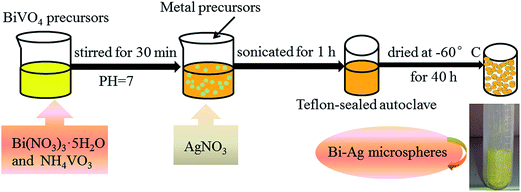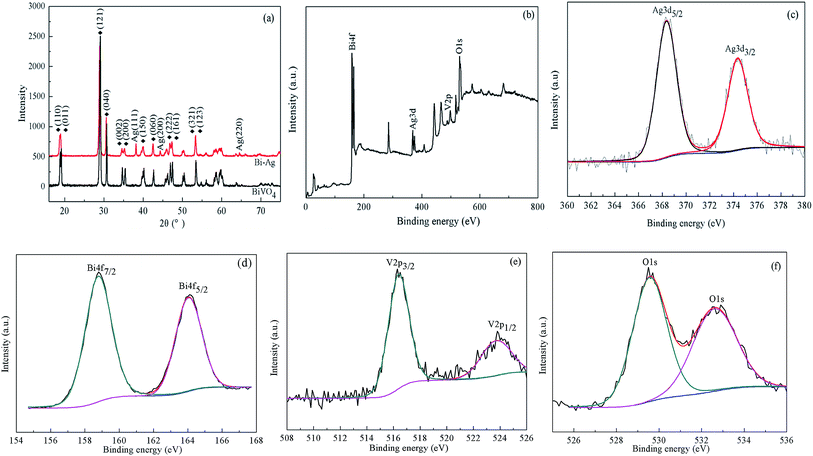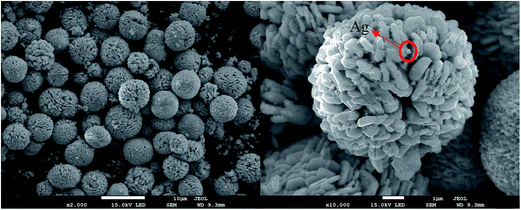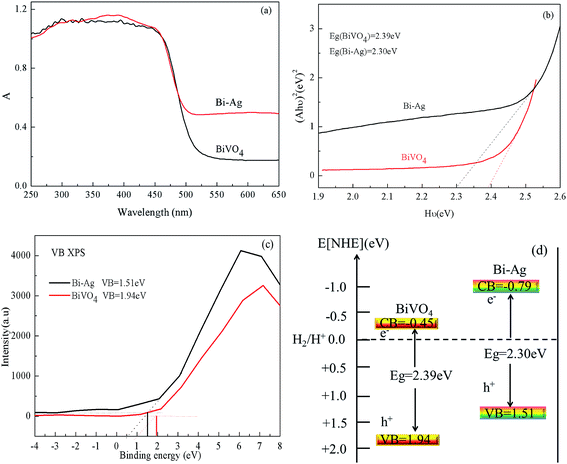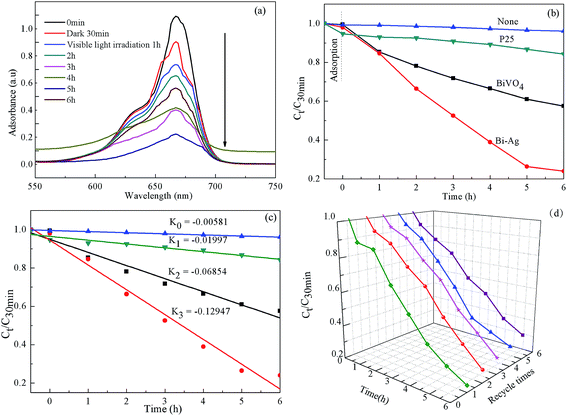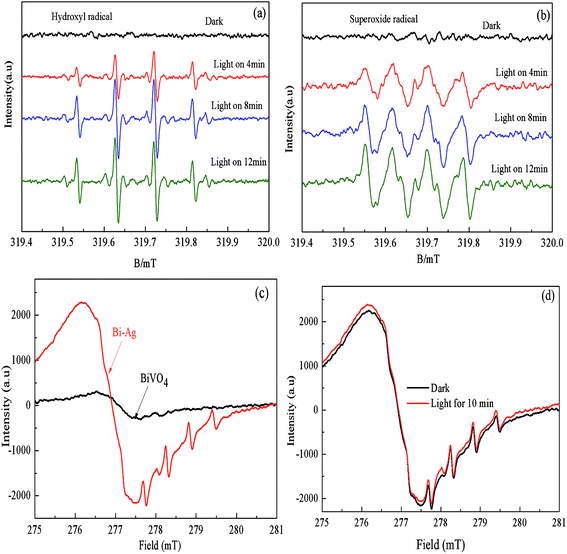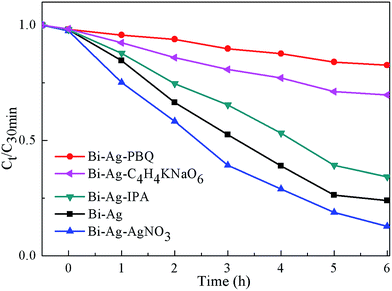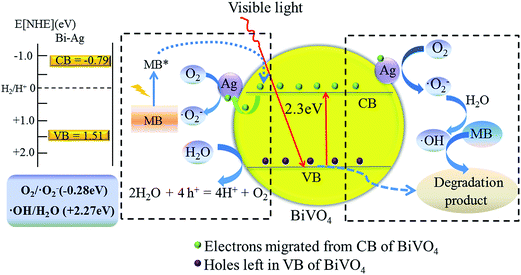New insights into Ag-doped BiVO4 microspheres as visible light photocatalysts
Xuan Xuab,
Mao Dua,
Tian Chenc,
Shimin Xionga,
Tianhui Wua,
Deqiang Zhaoa and
Zihong Fan*d
aKey Laboratory of Three Gorges Reservoir Region's Eco-Environment, Ministry of Education, Chongqing University, Chongqing 400045, China
bNational Centre for International Research of Low-Carbon and Green Buildings, Chongqing University, Chongqing 400045, China
cSchool of Mines, Key Laboratory of Deep Coal Resource Mining, Ministry of Education of China, China University of Mining and Technology, Xuzhou 221116, China
dCollege of Environmental and Resources, Chongqing Technology and Business University, Chongqing 400067, China. E-mail: 215928298@qq.com; Tel: +86-139-9622-1283
First published on 7th October 2016
Abstract
This study describes the synthesis of Ag–bismuth vanadate (Ag–BiVO4) microspheres, a highly efficient visible light photocatalyst for the degradation of methylene blue, via a one-step hydrothermal method. Multiple characterization techniques showed that bulk, monoclinic, needle-like BiVO4 and Ag nanoparticles (50 nm diameter) formed microspheres (3–7 μm diameter) with a uniform size distribution. Compared with pure BiVO4, the Bi–Ag microspheres showed significantly enhanced absorption of visible light (480 to 700 nm) during measurement of UV-Vis diffuse reflectance. Electron paramagnetic resonance measurements indicated that Ag doping enhanced photocatalytic performance because it facilitated separation and transfer of photo-generated electrons and electron holes. This study provides a cost-effective approach for synthesizing Bi–Ag microspheres with enhanced photocatalyst performance for environmental and energy applications.
1. Introduction
Photocatalysis technologies based on semiconductor materials that convert solar energy into chemical energy can be used to neutralize organic contamination.1,2 More than 190 different semiconductors are suitable photocatalysts for photoelectron chemical applications.3 Bismuth vanadate (BiVO4), a promising photocatalyst that uses visible light, has received considerable attention. BiVO4 has three primary crystal structures: tetragonal zircon, tetragonal scheelite, and monoclinic scheelite. The monoclinic scheelite phase of BiVO4 has a band gap of 2.4 eV and exhibits much higher photocatalytic activity in visible light in comparison with that of the other two phases.4–6 Nevertheless, the monoclinic scheelite phase of BiVO4 has very low quantum efficiency because photo-generated electron–hole pairs recombine relatively rapidly.7–9Recombination of electron–hole pairs can be inhibited by the deposition of noble metals onto the surface of BiVO4.10 In comparison with nanoparticles of other noble metals, Ag nanoparticles have attracted considerable attention because of their unique physicochemical properties and their potential in optical applications and as co-catalysts of semiconductors.11,12 The incident visible light on the surface of Ag nanoparticles can induce collective oscillations of conduction electrons with a resonant frequency in a phenomenon known as localized surface plasmon resonance (SPR), which is associated with strong absorption of visible light.13–15 Ag nanoparticles can facilitate electron transfer from the conduction band of BiVO4.16 Thus, Ag nanoparticles can significantly improve the quantum efficiency of semiconductor materials.13 However, a hydrothermal method of synthesizing small, highly monodisperse Ag–BiVO4 microspheres has not been reported.
Good morphology also can improve catalyst's activity as well as absorption capacity of light.17,18 Here, we describe a hydrothermal method for synthesizing Ag–BiVO4 microspheres. Compared with other morphology, this 3D microspheres structure, with reflecting and scattering effects, can increase the response range and absorption of light.19 Our results demonstrate that bulk, monoclinic, needle-like BiVO4 and Ag nanoparticles form microspheres (3–7 μm diameter) with a uniform size distribution, facilitating transport of photo-generated electrons in BiVO4 and thereby reducing the recombination rate of photo-generated charge carriers in the coupled Ag–BiVO4 composite system. Moreover, we demonstrate separation of the electron–hole pair. Finally, we show that photodegradation of methylene blue (MB) catalyzed by Ag–BiVO4 microspheres was more efficient than that catalyzed by pure BiVO4 under visible light irradiation.
2. Experimental
2.1. Experimental materials
The following analytically pure chemicals were used: bismuth nitrate (Bi(NO3)3·5H2O, Chengdu Area of the Industrial Development Zone Xinde Mulan, Chengdu, China), silver nitrate (AgNO3, 99.0%, Chongqing Chuandong Chemical Company, Chongqing, China), 25% ammonia solution (NH3·H2O, Chongqing Chuandong Chemical Company), sodium hydroxide powder (NaOH, Chongqing Chuandong Chemical Company), polyvinylpyrrolidone (PVP, Chengdu Area of the Industrial Development Zone Xinde Mulan), ammonium metavanadate (NH4VO3, Chongqing Chuandong Chemical Company), nitric acid (HNO3, Chengdu Area of the Industrial Development Zone Xinde Mulan), MB dye (Tianjin Guangfu Fine Chemical Research Institute, Tianjin, China), and ethylene glycol (Chongqing Chuandong Chemical Company, Chongqing, China).2.2. Synthesis of Ag–BiVO4 microspheres
In a typical experiment, 10 mmol of Bi(NO3)3·5H2O and 2.0 mL of PVP (0.5%) were dissolved in 50 mL of 2 mol L−1 HNO3 solution, after which the pH was adjusted to 7 with a solution of NH3·H2O. Next, 10 mmol of NH4VO3 was dissolved in 50 mL of 2 mol L−1 NaOH solution. These two solutions were combined and stirred vigorously for 30 min while 0.02 g of sodium dodecyl benzene sulfonate was added to the resulting solution. The pH of the mixed solution was adjusted to 7 with a solution of NH3·H2O. Separately, 323.9 mg AgNO3 powder was dissolved in 10 mL of ethylene glycol, after which the resulting solution was added to the mixed BiVO4 solution. The resulting solution of BiVO4 and AgNO3 was sonicated for 1 h, forming a homogeneous suspension, which was transferred to a 100 mL Teflon-sealed autoclave, which was maintained at 473.15 K for 18 h to achieve crystallization of the composite. The resulting precipitate was centrifuged, washed eight times with ethanol, and dried in a vacuum freeze drier at −60 °C for 40 h. The synthesized binary composite was designated as Bi–Ag microspheres. The process used to produce Bi–Ag microspheres is illustrated in Scheme 1.2.3. Characterization
Powder X-ray diffraction (XRD) spectra were acquired with a Rigaku D/Max-rB diffractometer with Cu Kα radiation. X-ray photoelectron spectroscopy (XPS) was performed with an Al Kα X-ray source (Thermo Fisher Scientific, K-Alpha, UA), and all binding energy values were corrected by calibration to the C 1s peak at 284.6 eV. Scanning electron microscopy (SEM) images were acquired with a JSM-7800F JEOL microscope. Energy dispersive X-ray (EDX) images were acquired with an EDX-100A-4. UV-Visible diffuse-reflectance spectroscopy (UV-Vis DRS) was performed with a Hitachi U-3010 UV-Vis spectrometer. Electronic paramagnetic resonance (EPR) analyses were performed using a JES FA200 X-band EPR spectrometer operating in the X-band at 0.907 GHz and 0.998 mW. Portions of the solid samples (50 mg) were introduced into a spectroscopic quartz probe cell, after which measurements were obtained at room temperature under visible light irradiation in air.2.4. Evaluation of visible light photocatalytic activity
Photocatalytic degradation of MB was assessed in a water-cooled aqueous solution illuminated with visible light at room temperature. The as-prepared semiconductor material (50 mg) was mixed with an aqueous solution of MB (200 mL, 5 mg L−1), followed by magnetic stirring in the dark for at least 30 min to establish the adsorption–desorption equilibrium of MB on the surface of pure BiVO4 and Bi–Ag microspheres. The reaction system was then subjected to visible-light irradiation using a Xe lamp (500 W; λ ≥ 400 nm). A series of aqueous samples (8 mL) were collected and centrifuged at 10![[thin space (1/6-em)]](https://www.rsc.org/images/entities/char_2009.gif) 000 rpm for 10 min to remove essentially all of the catalyst. The concentration of MB was determined by monitoring its characteristic absorption at 665 nm on a UV-Vis spectrophotometer.
000 rpm for 10 min to remove essentially all of the catalyst. The concentration of MB was determined by monitoring its characteristic absorption at 665 nm on a UV-Vis spectrophotometer.
3. Results and discussion
3.1. X-ray diffraction and XPS spectra
Fig. 1a shows the XRD patterns of pure BiVO4 and Bi–Ag microspheres. All primary diffraction peak patterns had good correspondence with that of monoclinic scheelite BiVO4 (JCPDS 14-0688), indicating that highly pure monoclinic scheelite BiVO4 was obtained using a one-step method.20 The Ag–BiVO4 diffractogram showed some new peaks that were not present in that of pure BiVO4. The peaks at 38.1°, 44.3°, and 64.4° were assigned to the (111), (200), and (220) planes of face-centered cubic (FCC) Ag (JCPDS card no. 65-2871),21 respectively.The survey XPS spectrum (Fig. 1b) shows that the composite contained Ag, Bi, O, and V. The high-resolution XPS spectrum of the Bi–Ag microspheres (Fig. 1c) shows that the peaks at binding energies of 374.1 and 368.1 eV can be ascribed to the Ag 3d3/2 and Ag 3d5/2 signals, respectively, suggesting the presence of metallic Ag.22 The high-resolution XPS spectra of Bi 4f, V 2p, and O 1s are shown in Fig. 2d–f. The strong peaks at 164.66 eV and 159.36 eV (Fig. 2d) corresponding to Bi 4f5/2 and Bi 4f7/2 are characteristic of Bi3+, indicating that the Bi in the composite is Bi3+.23 The V 2p peaks at 524.26 eV and 516.74 eV are assignable to V 2p1/2 and V 2p3/2 signals, respectively (Fig. 2e), indicating that the V species in the composite is V5+.24 The XRD and XPS results demonstrate conclusively that the tested sample consisted of Bi–Ag microspheres.
3.2. SEM and energy dispersive X-ray
Fig. 2 shows SEM images of Bi–Ag microspheres. Fig. 2a demonstrates that microspheres with diameters ranging from 3–7 μm were formed. Fig. 2b shows the structure of a single microsphere. The Bi–Ag microsphere structure creates a good interface between BiVO4 and the Ag nanoparticles; the Ag nanoparticles can facilitate electron transfer from the conduction band of BiVO4, which reduces the recombination rate of the photo-generated electron–hole pairs. In addition, Fig. 2b shows mass-dispersive Ag nanoparticles in the composite, which produce SPR and enhance absorption of visible light. Therefore, we expect Bi–Ag microspheres to have relatively good photocatalytic activity.To determine the spatial distribution of elements in the Bi–Ag microsphere structure, elemental mapping was performed using a single Bi–Ag microsphere. The composite was composed primarily of Ag, Bi, O, and V (Fig. 3). A comparison of the spectra indicated that the uniformly distributed microspheres consisted primarily of BiVO4 and Ag nanoparticles. The SEM and EDX results suggest that the BiVO4 and Ag nanoparticle composites were successfully synthesized using the one-step hydrothermal method. These results are consistent with, and support, those of the XRD and XPS analyses.
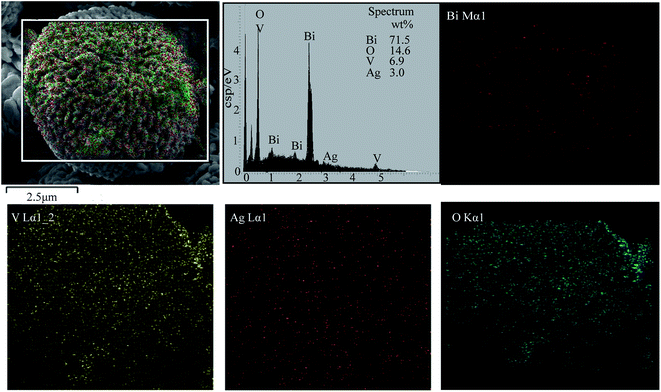 | ||
| Fig. 3 Energy dispersive X-ray spectrum of the Bi–Ag microspheres and corresponding EDX elemental mapping results. | ||
3.3. Light absorption and band structure
The light absorption characteristics of the samples were investigated (Fig. 4a). The UV-Vis DRS spectrum of the Bi–Ag microspheres was red-shifted in comparison with that of pure BiVO4. Ag nanoparticles show intense SPR absorption in the visible region, which is highly sensitive to their diameter and length-to-diameter ratio, as well as the optical and electronic properties of their surroundings. In this study, incorporation of Ag slightly reduced the size of the band gaps and enhanced visible light absorption, suggesting that utilization of visible light was enhanced by combining Ag nanoparticles with BiVO4.25Moreover, the energy band structures of a semiconductor continue to be important in determining its photocatalytic activity. The relationship of absorbance and incident photon energy hν can be described by eqn (1)
| Ahν = C(hν − Eg)1/2 | (1) |
The valence band (VB) edges of pure BiVO4 and the Bi–Ag microspheres were estimated to be 1.94 eV and 1.51 eV, respectively (Fig. 4c). According to Fig. 4b and c, the bandgap structures of pure BiVO4 and the Bi–Ag microspheres were determined as shown in Fig. 4d. The conduction band (CB) of the Bi–Ag microsphere sample was shifted to a more negative position in comparison with that of pure BiVO4. In general, as the CB value becomes more negative, the number of reductive photo-excited electrons generated increases, and good charge carrier transport results in little electron–hole recombination.28,29 This finding suggests that Bi–Ag microspheres have photocatalytic performance better than that of pure BiVO4.28–30 Therefore, the minimum CB value of the Bi–Ag microspheres was increased because of the Ag nanoparticles.31 These results indicate that the Bi–Ag microspheres have a unique electronic structure and significantly enhanced photocatalytic redox ability and photocatalytic performance under visible light irradiation in comparison with pure BiVO4.
3.4. Photocatalytic activity and stability
The photocatalytic activities of the samples were evaluated by analyzing the degradation of MB under visible light irradiation. As shown in Fig. 5b, the photodegradation efficiency of MB by the Bi–Ag microspheres was approximately 76% within 6 h. The superior photocatalytic performance of the Bi–Ag microspheres can be explained by their enhanced visible light absorption and high-efficiency separation of photogenerated charge carriers. P25 only absorbs UV light, so its photo-degradation efficiency is reduced in visible light.The stability of the Bi–Ag microspheres was investigated by assessing cyclic degradation of MB under visible light irradiation (Fig. 5d). The proportion of MB that was degraded was essentially constant over five cycles. Therefore, the Bi–Ag microspheres have good photocatalytic stability.
3.5. Reaction mechanism
The photoactivity of a photocatalyst is determined primarily by its capacity to absorb sunlight and separate excited electron–hole pairs.32 To identify the radical species that evolve during the photocatalytic reaction, EPR analysis was employed to detect ˙OH and O2˙− radicals under visible light irradiation33,34 (Fig. 6a and b). The ESR spectra of Bi–Ag microspheres irradiated with visible light revealed the four characteristic peaks of DMPO–˙OH adducts (1:2:2:1 quartet pattern), as well as the four characteristic peaks of DMPO–O2˙− adducts. Fig. 6a and b show that no EPR spectral peaks were observed when the reaction was performed in the dark, whereas signals with intensity corresponding to the characteristic peaks of DMPO–˙OH and DMPO–O2˙− adducts were observed when the reaction was performed under visible light irradiation, and the intensity gradually increased as the reaction time was prolonged.35 Generation of O2˙− inhibited recombination of photo-induced charge carriers and enhanced degradation of MB. The hydroxyl radical OH is formed via the e− → O2˙− → H2O2 → ˙OH route, whereas ˙OH radicals are formed by multistep O2˙− reduction.36,37 These results suggest that O2˙− and ˙OH are active species formed in the presence of Bi–Ag microspheres and oxygen under visible light irradiation (Fig. 6a and b).The EPR spectra confirm the separation of electron–hole pairs in the Bi–Ag microsphere powder and pure BiVO4 powder37–39 (Fig. 6c and d). The obvious peaks associated with trapped electrons in the Bi–Ag microspheres were noticeably higher than those of fully hydrated, pure BiVO4 (Fig. 6c). For better visualization, the peaks corresponding to holes/oxidation products were normalized for the spectra presented in Fig. 6c, and lines were drawn to indicate the relative intensities of the photo-generated electrons.40 The electron–hole pairs of the Bi–Ag microspheres had better separation than those of pure BiVO4 under illumination with visible light (Fig. 6c). The Bi–Ag microspheres illuminated for 10 min exhibited a stronger signal intensity at the 278 mT peak (g = 2.002) in comparison with those in the dark (Fig. 6d), indicating that visible light illumination induced separation of electron–hole pairs. Because the EPR spectra were recorded under illumination, the intensities of the signals correspond to the steady-state concentrations of products, which depend on the formation and recombination of electrons, holes, and the products of their subsequent reactions.20
In photocatalysts, reactive species such as O2˙−, h+, e+, and ˙OH function as bridges during photodegradation of organic pollutants under visible light irradiation.41 To investigate the photocatalytic mechanism of the Bi–Ag microspheres and determine the reasons for their improved performance, the effects of scavengers on MB degradation was examined to clarify the contributions of various reactive species during photocatalysis. We used p-benzoquinone (PBQ, 0.1 mmol), isopropanol (IPA, 0.1 mmol L−1), silver nitrate (AgNO3, 0.1 mmol), and potassium sodium tartrate (C4H4O6KNa·4H2O, 0.1 mmol) as O2˙−,˙OH, hole, and electron scavenger, respectively.42,43 These scavengers were added to the MB solution together with the Bi–Ag microspheres before irradiation. The results of these experiments indicate essentially complete inhibition of MB degradation in the presence of PBQ (Fig. 7), suggesting that O2˙− is the major reactive species contributing to photocatalytic degradation of MB over Bi–Ag microspheres. The dramatic decrease in degradation of MB in the presence of C4H4O6KNa·4H2O demonstrates that h+ also plays an important role in photodegradation of MB over Bi–Ag microspheres, which was further confirmed by slight enhancement of MB degradation after the addition of AgNO3 to capture photogenerated electrons. These results also demonstrate that MB can be degraded by the hole directly. The removal yields of Bi–Ag microspheres were decreased in the presence of IPA, indicating that ˙OH, produced from the reaction of O2˙− with H2O, has an important effect on MB degradation. The results of the scavenging experiments were consistent with the results of the EPR analysis.
A reaction mechanism was posited based on the results of the experiments described above (Fig. 8). The adsorbed MB would be photo-activated by visible light, so that electrons can transfer from the singlet excited MB (MB*) to the CB of BiVO4, Ag nanoparticles, and the shallow trap levels in the band gap of BiVO4. The electrons on the BiVO4 surface are subsequently trapped by the Ag nanoparticles, separating the MB˙+ and electrons, thus preventing recombination.30,33 The SPR of the Ag nanoparticles excited by solar light enhances the excitation of surface electrons and the transfer of interfacial electrons.31 Under visible light excitation, the BiVO4 surface generates electron–hole pairs, followed by rapid transfer of photo-generated electrons to Ag nanoparticles. Next, the negatively charged Ag nanoparticles activate O2 to produce O2˙−, which reacts with H2O to produce ˙OH. Finally, the holes, ˙OH, and O2˙− oxidize the dye molecules adsorbed on the active sites of the Bi–Ag photocatalyst.44,45 The entire sequence is summarized in the following five reactions:
| BiVO4 + hν → BiVO4 (h + e) | (2) |
| BiVO4 (e) + Ag → BiVO4 + Ag (e) | (3) |
| Ag (e) + O2 → O2˙− + Ag | (4) |
| O2˙− + H2O → H2O2 + ˙OH | (5) |
| BiVO4 (h) + ˙OH + O2˙− + MB → degradation product | (6) |
4. Conclusions
Bi–Ag microspheres were synthesized by a facile one-step hydrothermal method and shown to function as a photocatalyst. The Bi–Ag microspheres have a lower band gap comparing with pure BiVO4 as a result of the VB and CB shifting in the same direction. The band structure variation was caused by Ag nanoparticles associated with BiVO4 after the hydrothermal reaction. These features resulted in a unique electronic structure that prolonged the duration of photocatalysis and improved the photo-oxidation ability of the charge carriers, promoting visible light photocatalysis. Consequently, the photocatalytic activity and oxidation capacity of the Bi–Ag microspheres toward MB was significantly enhanced. Bi–Ag microspheres have superior, persistent photocatalytic performance and are expected to be utilized in a wide range of industrial applications to eliminate organic pollutants from wastewater. The unique electronic structure identified in this study can be applied to develop novel high-performance photocatalysts.Conflicts of interest
The authors declare that there are no conflicts of interest regarding the publication of this paper.Author contributions
Xuan Xu, Mao Du, and Zihong Fan conceived of the study and designed the experiments; Mao Du, Tianhui Wu, and Shimin Xiong performed the experiments; Mao Du, Deqiang Zhao, and Tian Chen analyzed the data; Zihong Fan contributed reagents/materials/analysis tools; Mao Du wrote the paper.Acknowledgements
We gratefully acknowledge support from the 111 Project (No. B13041), the Science and Technology Innovation Special Projects of Social Undertakings and Livelihood Support, Chongqing (cstc2015shmsztzx20003, cstc2016shmszx20009), the graduate scientific research and innovation foundation of Chongqing, China (grant NO. CYB16008), the Science and Technology Project of Chongqing Education Commission (KJ1500604) and the Chongqing Research Program of Basic Research and Frontier Technology (cstc2015jcyjA20013).References
- R. Li, H. Han, F. Zhang, D. Wang and C. Li, Highly efficient photocatalysts constructed by rational assembly of dual-cocatalysts separately on different facets of BiVO4, Energy Environ. Sci., 2014, 7, 1369–1378 CAS.
- Z. Xing, W. Zhou, F. Du, Y. Qu, G. Tian, K. Pan, C. Tian and H. Fu, A floating macro/mesoporous crystalline anatase TiO2 ceramic with enhanced photocatalytic performance for recalcitrant wastewater degradation, Dalton Trans., 2014, 43, 790–798 RSC.
- F. Fresno, R. Portela, S. Suárez and J. M. Coronado, Photocatalytic materials: Recent achievements and near future trends, J. Mater. Chem. A, 2014, 2, 2863–2884 CAS.
- P. Wang, J. Y. Zheng, D. Zhang and Y. S. Kang, Selective construction of junctions on different facets of BiVO4 for enhancing photo-activity, New J. Chem., 2015, 39, 9918–9925 RSC.
- Y. Park, K. J. McDonald and K. S. Choi, Progress in bismuth vanadate photoanodes for use in solar water oxidation, Chem. Soc. Rev., 2013, 42, 2321–2337 RSC.
- K. Sayama, A. Nomura and T. Arai, Photoelectro chemical decomposition of water into H2 and O2 on porous BiVO4 thin-film, J. Phys. Chem. B, 2006, 110(23), 11352–11360 CrossRef CAS PubMed.
- Y. Sun, Y. Xie, C. Wu, S. Zhang and S. Jiang, Aqueous synthesis of mesostructured BiVO4 quantum tubes with excellent dual response to visible light and temperature, Nano Res., 2010, 3, 620–631 CrossRef CAS.
- J. Li, J. Zhou, H. Hao and Z. Zhu, Silver-modified specific (040) facet of BiVO4 with enhanced photoelectron chemical performance, Mater. Lett., 2016, 170, 163–166 CrossRef CAS.
- T. Saison, N. Chemin, C. Chanéac, O. Durupthy, L. Mariey, F. Maugé, V. Brezová and J.-P. Jolivet, New insights into BiVO4 properties as visible light photocatalyst, J. Phys. Chem. C, 2015, 119, 12967–12977 CAS.
- X. Lin, X. Guo, W. Shi, L. Zhao, Y. Yan and Q. Wang, Ternary hetero-structured Ag–BiVO4/InVO4 composites: Synthesis and enhanced visible-light-driven photocatalytic activity, J. Alloys Compd., 2015, 635, 256–264 CrossRef CAS.
- Y. Liang and J. Messinger, Improving BiVO4 photoanodes for solar water splitting through surface passivation, Phys. Chem. Chem. Phys., 2014, 16, 12014–12020 RSC.
- S. Chala, K. Wetchakun, S. Phanichphant, B. Inceesungvorn and N. Wetchakun, Enhanced visible-light-response photocatalytic degradation of methylene blue on Fe-loaded BiVO4 photocatalyst, J. Alloys Compd., 2014, 597, 129–135 CrossRef CAS.
- P. Wang, Y. Tang, Z. Dong, Z. Chen and T.-T. Lim, Ag–AgBr/TiO2/RGO nanocomposite for visible-light photocatalytic degradation of penicillin g, J. Mater. Chem. A, 2013, 1, 4718 CAS.
- M. Sun, Q. Zhao, X. Liu, C. Du and Z. Liu, Comparative study on sandwich-structured SiO2@Ag@SnO2 and inverse SiO2@SiO2@Ag: key roles of shell ordering and interfacial contact in modulating the photocatalytic properties, RSC Adv., 2015, 5, 81059–81068 RSC.
- G. Li, Y. Wang and L. Mao, Recent progress in highly efficient Ag-based visible-light photocatalysts, RSC Adv., 2014, 4, 53649–53661 RSC.
- S. Kohtani, J. Hiro, N. Yamamoto, A. Kudo, K. Tokumura and R. Nakagaki, Adsorptive and photocatalytic properties of Ag-loaded BiVO4 on the degradation of 4-N-alkylphenols under visible light irradiation, Catal. Commun., 2005, 6, 185–189 CrossRef CAS.
- J. Su, L. Guo, S. Yoriya and C. A. Grimes, Aqueous growth of pyramidal-shaped BiVO4 nanowire arrays and structural characterization: application to photoelectrochemical water splitting, Cryst. Growth Des., 2010, 10, 856–861 CAS.
- Y. Sun, C. Wu, R. Long, Y. Cui, S. Zhang and Y. Xie, Synthetic loosely packed monoclinic BiVO4 nanoellipsoids with novel multiresponses to visible light, trace gas and temperature, Chem. Commun., 2009, 4542–4544 RSC.
- T. Xiong, F. Dong and Z. Wu, Enhanced extrinsic absorption promotes the visible light photocatalytic activity of wide band-gap (BiO)2CO3 hierarchical structure, RSC Adv., 2014, 4, 56307–56312 RSC.
- C. Yin, S. Zhu, Z. Chen, W. Zhang, J. Gu and D. Zhang, One step fabrication of C-doped BiVO4 with hierarchical structures for a high-performance photocatalyst under visible light irradiation, J. Mater. Chem. A, 2013, 1, 8367 CAS.
- D. Wang, Z.-H. Zhou, H. Yang, K.-B. Shen, Y. Huang and S. Shen, Preparation of TiO2 loaded with crystalline nano Ag by a one-step low-temperature hydrothermal method, J. Mater. Chem., 2012, 22, 16306 RSC.
- K. Wang, L. Liang, H. Liu, X. Xie, Q. Hao and C. Liu, Facile synthesis of hollow and porous Ag+/Ag/BiVO4 composite fibers with enhanced visible-light photocatalytic performance, Mater. Lett., 2015, 161, 336–339 CrossRef CAS.
- X. Lin, J. Hou, S. Jiang, Z. Lin, M. Wang and G. A. Che, Z-scheme visible-light-driven Ag/Ag3PO4/Bi2MO6 photocatalyst: synthesis and enhanced photocatalytic activity, RSC Adv., 2015, 5, 104815–104821 RSC.
- D. D. Qin, T. Wang, Y. M. Song and C. L. Tao, Reduced monoclinic BiVO4 for improved photoelectron chemical oxidation of water under visible light, Dalton Trans., 2014, 43, 7691–7694 RSC.
- T. E. Jones, T. C. Rocha, A. Knop-Gericke, C. Stampfl, R. Schlogl and S. Piccinin, Adsorbate induced vacancy formation on silver surfaces, Phys. Chem. Chem. Phys., 2014, 16, 9002–9014 RSC.
- M. Du, S. Xiong, T. Wu, D. Zhao, Q. Zhang, Z. Fan, Y. Zeng, F. Ji, Q. He and X. Xu, Preparation of a microspherical silver-reduced graphene oxide–bismuth vanadate composite and evaluation of its photocatalytic activity, Materials, 2016, 9, 160 CrossRef.
- S. Dong, Y. Cui, Y. Wang, Y. Li, L. Hu, J. Sun and J. Sun, Designing three-dimensional acicular sheaf shaped BiVO4/reduced graphene oxide composites for efficient sunlight-driven photocatalytic degradation of dye wastewater, Chem. Eng. J., 2014, 249, 102–110 CrossRef CAS.
- T. E. Jones, T. C. Rocha, A. Knop-Gericke, C. Stampfl, R. Schlogl and S. Piccinin, Adsorbate induced vacancy formation on silver surfaces, Phys. Chem. Chem. Phys., 2014, 16, 9002–9014 RSC.
- F. Dong, Y. Li, Z. Wang and W.-K. Ho, Enhanced visible light photocatalytic activity and oxidation ability of porous graphene-like g-C3N4 nanosheets via thermal exfoliation, Appl. Surf. Sci., 2015, 358, 393–403 CrossRef CAS.
- J. Xiong, Q. Sun, J. Chen, Z. Li and S. Dou, Ambient controlled synthesis of advanced core–shell plasmonic Ag@ZnO photocatalysts, CrystEngComm, 2016, 18, 1713–1722 RSC.
- X. Yan, S. Li, Y. Pan, B. Xing, R. Li, B. W. L. Jang and X. Liu, Tunable Ag+ release from Ag@C for antibacterial and antifouling performances, RSC Adv., 2015, 5, 39384–39391 RSC.
- X. Ma, Y. Tang, H. Tao, Y. Lai, Y. Zhang, X. Zhou, Z. Lv, Z. Zhu and J. Tao, Uniform spatial distribution of a nanostructured Ag/AgCl plasmonic photocatalyst and its segregative membrane towards visible light-driven photodegradation, CrystEngComm, 2016, 18, 3725–3733 RSC.
- M. Yan, Y. Wu, Y. Yan, X. Yan, F. Zhu, Y. Hua and W. Shi, Synthesis and characterization of novel BiVO4/Ag3VO4 heterojunction with enhanced visible-light-driven photocatalytic degradation of dyes, ACS Sustainable Chem. Eng., 2016, 4, 757–766 CrossRef CAS.
- H.-P. Lin, W. W. Lee, S.-T. Huang, L.-W. Chen, T.-W. Yeh, J.-Y. Fu and C.-C. Chen, Controlled hydrothermal synthesis of Pb BiO2Br/BiOBr heterojunction with enhanced visible-driven-light photocatalytic activities, J. Mol. Catal. A: Chem., 2016, 417, 168–183 CrossRef CAS.
- C. Yang, F. Li and T. Li, A one-step ionic liquid-assisted ultrasonic method for the preparation of BiOCl/m-BiVO4 heterojunctions with enhanced visible light photocatalytic activity, CrystEngComm, 2015, 17, 7676–7683 RSC.
- M. Xie, Y. Feng, X. Fu, P. Luan and L. Jing, Phosphate-bridged TiO2–BiVO4 nanocomposites with exceptional visible activities for photocatalytic water splitting, J. Alloys Compd., 2015, 631, 120–124 CrossRef CAS.
- Z. Wang, W. Ma, C. Chen, H. Ji and J. Zhao, Probing paramagnetic species in titania-based heterogeneous photocatalysis by electron spin resonance (ESR) spectroscopy-a mini review, Chem. Eng. J., 2011, 170, 353–362 CrossRef CAS.
- N. M. Dimitrijevic, B. K. Vijayan, O. G. Poluektov, T. Rajh, K. A. Gray, H. He and P. Zapol, Role of water and carbonates in photocatalytic transformation of CO2 to CH4 on titania, J. Am. Chem. Soc., 2011, 133, 3964–3971 CrossRef CAS PubMed.
- K. C. Christoforidis and M. Fernández-García, Photoactivity and charge trapping sites in copper and vanadium doped anatase TiO2 nano-materials, Catal. Sci. Technol., 2016, 6, 1094–1105 CAS.
- C. P. Kumar, N. O. Gopal and T. C. Wang, EPR Investigation of TiO2 Nanoparticles with Temperature-Dependent Properties, J. Phys. Chem. B, 2006, 110(11), 5223–5229 CrossRef CAS PubMed.
- Q. Shi, W. Zhao, L. Xie, J. Chen, M. Zhang and Y. Li, Enhanced visible-light driven photocatalytic mineralization of indoor toluene via a BiVO4/reduced graphene oxide/Bi2O3 all-solid-state z-scheme system, J. Alloys Compd., 2016, 662, 108–117 CrossRef CAS.
- S. Kansal, N. Kaur and S. Singh, Photocatalytic degradation of two commercial reactive dyes in aqueous phase using nanophotocatalysts, Nanoscale Res. Lett., 2009, 4, 709–716 CrossRef CAS PubMed.
- L. Chen, R. Huang, M. Xiong, Q. Yuan, J. He, J. Jia, M. Y. Yao, S. L. Luo, C. T. Au and S. F. Yin, Room-temperature synthesis of flower-like BiOX (X horizontal line Cl, Br, I) hierarchical structures and their visible-light photocatalytic activity, Inorg. Chem., 2013, 52, 11118–11125 CrossRef CAS PubMed.
- L. Xu, F. Zhang, X. Song, Z. Yin and Y. Bu, Construction of reduced graphene oxide-supported Ag–Cu2O composites with hierarchical structures for enhanced photocatalytic activities and recyclability, J. Mater. Chem. A, 2015, 3, 5923–5933 CAS.
- J. Zhang, B. Wang, C. Li, H. Cui, J. Zhai and Q. Li, Synthesis of novel CeO2–BiVO4 composites with enhanced visible-light photocatalytic properties, J. Environ. Sci., 2014, 26, 1936–1942 CrossRef PubMed.
| This journal is © The Royal Society of Chemistry 2016 |

